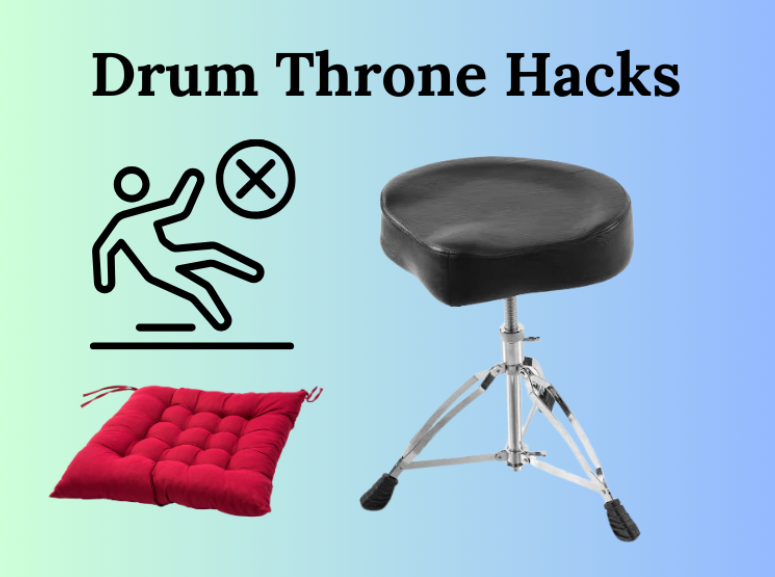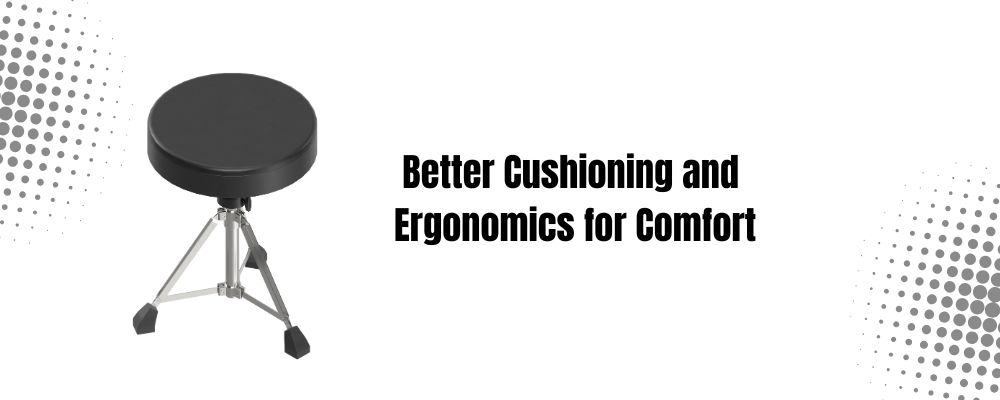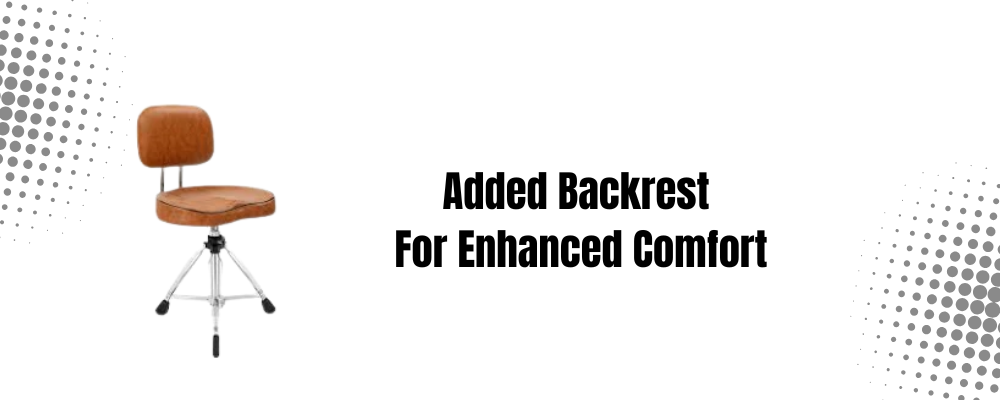Comfort isn’t a luxury for drummers—it’s a necessity. A poorly adjusted drum throne can wreck posture, cause fatigue, and throw off timing. But small tweaks can turn an average seat into a powerhouse of support.
From optimizing height to enhancing stability, a few creative modifications can drastically improve performance. The best part? Most of these hacks require minimal effort and cost next to nothing.
Imagine playing longer without back pain or keeping perfect balance during intense fills. That’s what a well-tuned drum throne can do. Whether you’re a casual player or a pro, these five hacks will help you unlock a new level of comfort and control in your studio.
Customize Cushion Support for Extended Comfort
A drum throne’s stock cushion isn’t always built for marathon sessions. Sitting for long hours on a stiff or overly soft seat can lead to discomfort, pressure buildup, and even circulation issues. Fortunately, upgrading your throne’s cushion can provide instant relief and improve endurance.
Choose the Right Cushion Material
Not all seat materials are created equal. Each offers distinct benefits depending on your playing style and comfort needs:
- Gel cushions conform to your body shape, reducing pressure points and preventing numbness. They distribute weight evenly, making them ideal for long rehearsals.
- Memory foam adapts to your posture, providing excellent support, though it can retain heat over time. If you sweat easily, pairing it with a breathable cover is a good move.
- Multi-layered foam combines firm and soft layers, striking a balance between support and comfort. It offers better durability while maintaining flexibility.
DIY Hacks to Improve Cushioning
If replacing your drum throne’s cushion isn’t an option, simple modifications can make a difference:
- Add a thin memory foam pad beneath the existing seat for extra shock absorption.
- Use an ergonomic seat cover with ventilation to reduce sweating and discomfort.
- Experiment with different fabric wraps—leather enhances durability, while mesh improves airflow.
Comfort directly affects focus and endurance. A well-padded seat ensures you can play longer without shifting uncomfortably or losing concentration.
Optimize Throne Height and Angle for Better Posture
An improperly adjusted drum throne can strain your lower back, reduce mobility, and even affect your playing speed. Finding the right height and angle isn’t just about comfort—it directly impacts control, endurance, and technique.
Adjustable drum thrones like 5 core padded drum stool, and Ludwig atlas drum throne provide great options if you are looking for adjustable drum thrones.
Dialing in the Perfect Height
Your knees should sit slightly below your hips when seated. A throne that’s too low forces excessive knee bending, creating tension in your legs and lower back. Too high, and you’ll struggle with balance and pedal control.
To find your ideal height:
- Sit down and place your feet naturally on the pedals.
- Adjust the seat until your thighs slope slightly downward.
- Test different settings while playing—subtle tweaks can make a huge difference.
Adjusting the Seat Angle for Maximum Stability
A flat seat isn’t always the best option. Tilting the throne slightly forward encourages a natural posture, preventing slouching and lower back fatigue. It also improves pedal reach, allowing for smoother, more controlled footwork.
- A slight forward tilt shifts weight towards your legs, reducing spinal pressure.
- A level seat is better if you prefer more stability and less movement.
- Avoid excessive tilting—it can strain your lower back instead of helping it.
Mastering these adjustments ensures you stay relaxed and in control, no matter how long your session lasts.
Enhance Stability with Anti-Slip Modifications
A wobbly drum throne isn’t just annoying—it messes with balance, control, and overall performance. Stability is crucial, especially during high-energy playing. Thankfully, a few simple modifications can lock your throne in place and eliminate unwanted movement.
Upgrade the Feet for Better Grip
Stock rubber feet can wear down over time, making your throne prone to slipping. Reinforcing them or replacing them with high-grip alternatives can make a big difference.
- Non-slip rubber pads add extra traction on smooth floors.
- Silicone chair leg caps provide better grip and reduce vibrations.
- DIY fix: Wrap gaffer tape or attach small rubber mats under the legs.
Add Weight for Extra Stability
Lightweight thrones can shift, especially when playing aggressively. Adding weight to the base helps anchor the seat for better control.
- Attach small ankle weights to the legs for a quick fix.
- Use a weighted floor mat underneath to increase friction.
- Consider a heavier throne base if upgrading in the future
Improve Mobility with a Swivel Seat Hack
A rigid drum throne can limit movement, making quick adjustments difficult during a performance. A smooth-swiveling seat enhances flexibility, allowing for effortless shifts between drums without straining your back or legs.
Lubricate the Swivel Mechanism
Over time, the rotating mechanism can become stiff, leading to jerky movements. Proper lubrication ensures smooth motion without resistance.
- Use silicone spray or white lithium grease to reduce friction.
- Apply lubricant to the central spindle and test the rotation.
- Wipe off excess to prevent dust buildup and slipping.
Modify for Controlled Rotation
A throne that spins too freely can be just as problematic as one that doesn’t move at all. If you need controlled movement:
- Add a friction washer to slow down excessive spinning.
- Tighten the height adjustment collar slightly to create resistance.
- Use a locking swivel base if you prefer occasional movement without full rotation.
A well-adjusted swivel lets you move freely without overcompensating, reducing strain and improving fluidity while playing.
Boost Comfort with a Backrest Attachment
Drumming for extended periods can strain your lower back, especially if posture isn’t maintained. A well-placed backrest provides crucial lumbar support, reducing fatigue and enhancing endurance.
Branded drum thrones like 5 core padded drum throne with backrest and temu drum throne with backrest are some quality options that you can opt for.
Choosing the Right Backrest
Not all drum thrones come with back support, but you can attach one or modify an existing seat for added comfort. Consider these options:
- Adjustable backrests let you fine-tune the angle for personalized support.
- Memory foam lumbar cushions offer a quick, removable solution.
- DIY fix: Attach a small ergonomic cushion using Velcro straps for flexibility.
Positioning for Maximum Support
A poorly positioned backrest can do more harm than good. To ensure proper alignment:
- Set it at a lower back height to maintain natural spinal curvature.
- Avoid leaning excessively—the goal is support, not dependence.
- Test different angles to find the perfect balance between comfort and mobility.
With the right back support, you can play longer without stiffness or fatigue, keeping your focus on the music instead of discomfort.
Conclusion
A well-optimized drum throne does more than just provide a place to sit—it enhances comfort, stability, and overall playing efficiency. Small tweaks like adjusting height, improving cushioning, or adding a swivel can make long sessions more enjoyable and reduce strain.
Experiment with these simple yet effective hacks to find the perfect setup for your needs. A comfortable drummer is a better drummer, and when your throne works for you, your performance and endurance naturally improve.
If you liked this article, find more here:




